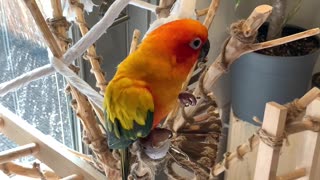Premium Only Content

How To Tell If Your Bird Has Mites
Subscribing to my channel is greatly appreciated!!
the day as the mites continue to burrow. In an attempt to remove the mites, your bird may also groom or preen himself excessively, though the mites cannot be removed by grooming or preening. Check if your bird is coughing, sneezing, open-mouth breathing, or has difficulty breathing.
Mites can also burrow and infest your bird’s trachea, air sacs, bronchi or sinuses, resulting in symptoms like coughing, sneezing, or difficulty breathing. Your bird may also start to open-mouth breathe, almost as if he is gasping for air. Watch him when he breathes in his cage for any signs of difficulty breathing or breathing with an open mouth. Your bird may also experience weight loss due to the mite infestation, and he may make clicking sounds or have a change in vocal sounds a result of mites burrowed in his respiratory system. Your bird may also experience weight loss due to the mite infestation, and he may make clicking sounds or have a change in vocal sounds a result of mites burrowed in his respiratory system.Look for any feather damage or feather loss.
Your bird may have noticeable feather damage, with missing patches of feathers or piles of feathers in his cage. This is as a result of excessive preening or cleaning by your bird in an attempt to remove the mites from his skin. Examine your bird’s head and legs at night for swarms of mites.
Since mites are nocturnal, they will reproduce during the day and feed at night. Use a flashlight to check your bird’s head and legs for any crawling mites during the night. They may appear as small, red or black spots or specks that move and burrow close to your bird’s skin.
-
 1:00
1:00
PlutoBirdie
4 years ago $0.01 earnedHow to Bond with Your Bird!
931 -
 22:39
22:39
mikehealy
4 years agoHow to Tell Your Compelling Story
71 -
 0:58
0:58
PlutoBirdie
4 years agoHow to teach your bird to trust hands!
412 -
 1:51:23
1:51:23
The Quartering
4 hours agoTrump Snub Backfires, Matt Walsh Sounds The Alarm, Candace Owens Theory On Charlie Kirk
104K38 -
 LIVE
LIVE
Owen Shroyer
1 hour agoOwen Report - 10-10-2025 - Qatari Airbase In America Angers Israeli Lobby
1,151 watching -
 1:14:53
1:14:53
DeVory Darkins
4 hours ago $13.04 earnedDemocrat Candidate leaves crowd DUMBFOUNDED as Trump scores MAJOR VICTORY
67.7K20 -
 1:12:16
1:12:16
Sean Unpaved
4 hours agoTNF Shocker: Giants Stomp Eagles, Cubs Claw a Game 5, Weekend NFL/CFB Best Bets!
29K6 -
 1:25:05
1:25:05
HotZone
9 hours ago $1.86 earned5 Signs Terrorists are Plotting a Massive US Strike
17.7K11 -
 1:05:42
1:05:42
Dear America
4 hours agoShould Christians Celebrate Halloween?
30.6K15 -
 2:03:24
2:03:24
The Culture War with Tim Pool
6 hours agoAntifa Is A Terror Organization, Crackdown Coming As Leftists Defend Violence | The Culture War
179K164